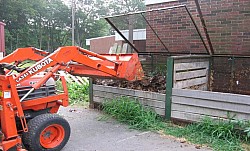September 30, 2014
NERC was awarded a Vermont Department of Environmental Conservation “Universal Recycling School Grant” to assist schools in Bennington County to implement food scrap composting. As I head off for my first onsite school visits, I thought it timely to revisit some school composting tips.
Getting started
Integrating food scrap collection into the cafeteria or lunchroom requires dedication and teamwork to ensure success and sustainability.
Form a Compost Team & choose a coordinator:The team should include representatives from administration, teachers, custodial and cafeteria staff, parents, and students. The Team will be responsible for program development, ensuring that there is administrative, staff, and student support for the program, and ultimately likely to be responsible for oversight of the composting efforts.
Choose a composting option: A suitable composting system depends on a variety of factors, including whether there are available offsite services (processing and hauling) or an onsite area suitable for composting; the amount of food waste generated; and, the student body size and age.
Formulate a budget:There will be costs associated with the introduction of a composting program but these can likely be offset by avoided disposal costs. Examples of costs include: hauling and container rental charges for offsite composting; compost bins and shovels for onsite composting. There will also be labor costs associated with the program, but these will vary depending upon the compost system and the availability of students to assist.
Conduct a cafeteria waste sort: Calculations from the waste sort will be used to estimate the number of compost bins needed for onsite composting or the amount of storage area needed for offsite composting. Consider at least three sorts: compostables (food scraps and soiled paper); non-compostable wastes (straws, plastic wrap, etc.); and recyclables.
Decide how compost will be collected and handled:The Team will need to decide how the materials will be collected in the kitchen/cafeteria. Five-gallon buckets with lids work well; often these are available at no cost from restaurants or stores. Small tubs, or small carts on wheels also work.
How materials will be moved to the storage area for offsite composting or to the onsite composting area must also be determined. Food scraps are heavy, so smaller containers or carts on wheels work best, especially if students are involved with moving the materials.
Composting onsite
Composting food waste on school grounds requires dedication and a long-term maintenance commitment, but it is likely the least expensive option. To compost onsite, a suitable location must be determined; containers will need to be built or purchased; and, equipment and supplies obtained. A dedicated team will be needed to manage the compost site and ensure that materials are composted properly.
Composting offsite
The Compost Team will need to find a hauler and a compost facility. Several resources can help in this search: local solid waste officials, the school’s waste hauler, or the Internet (e.g., www.findacomposter.com). The Team will need to determine how the materials will get from the school to the compost operation and any costs involved.
Determine materials to be composted
A commercial compost operation or digester can often accept a wider range of materials than could be composted onsite. These include soiled paper (such as napkins) and all food scraps, even meat. However, pig or livestock operations may only accept vegetable scraps.
Making it happen
Once the compost system is determined (offsite or onsite), the Compost Team is ready to assign project tasks, develop a schedule, and train students and staff. Decide how the materials will be transferred from the kitchen to the compost or storage area and who will carry out these tasks. A schedule of tasks and assigning individuals (e.g., classes, student clubs) to complete each task will ensure that everything gets done.
Be sure to start the program slowly—with one lunch period or one grade period, for example. Place cafeteria collection bins near where students normally bus tables. Label each bin with easy to read signage and with pictures. Consider having students design and create the signage so that the “right” message is communicated about what to compost. The Compost Team will need to schedule student volunteers to monitor the collection. Monitors assist younger students in sorting their compostable scraps and help older students learn what is acceptable and not acceptable.
Promote the program
Promoting the program and its impact will help to maintain enthusiasm and participation in the program by students, faculty, and staff.
School composting, whether offsite or onsite, is a formidable challenge. The benefits, however, can be substantial—from significant reductions in waste to a wide array of educational opportunities. For school recycling and composting resources, visit NERC’s website.
By Athena Lee Bradley



Comments (0)
Add a Comment